Tools and decorative objects of the Stone Age Index

A comprehensive overview of ancient tools, from the earliest times to the end of the ice ages.
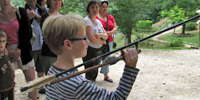
Atlatls, Spear Throwers, and Woomeras - an atlatl or spear-thrower is a tool that uses leverage to achieve greater velocity in dart-throwing. It consists of a shaft with a cup or a spur at the end that supports and propels the butt of the dart. A traditional atlatl is a long-range weapon and can readily impart to a projectile speeds of over 150 km/h (93 mph).
 Baguettes demi-rondes are a two-part composite projectile point technology usually manufactured from antler. This method of point construction allowed the Magdalenian toolmaker to construct a projectile point of much larger proportions, with high stiffness and strength, than the physical constraints imposed by the raw material usually allowed.
Baguettes demi-rondes are a two-part composite projectile point technology usually manufactured from antler. This method of point construction allowed the Magdalenian toolmaker to construct a projectile point of much larger proportions, with high stiffness and strength, than the physical constraints imposed by the raw material usually allowed.
 Bâtons Percés - A key discovery by Conard’s team in Hohle Fels Cave in southwestern Germany is rewriting the history of rope. The find is a carefully carved and beautifully preserved piece of mammoth ivory 20.4 cm in length with four holes between 7 and 9 mm in diameter. Each of the holes is lined with deep, and precisely cut spiral incisions. The new find demonstrates that these elaborate carvings are technological features of rope-making equipment rather than just decoration.
Bâtons Percés - A key discovery by Conard’s team in Hohle Fels Cave in southwestern Germany is rewriting the history of rope. The find is a carefully carved and beautifully preserved piece of mammoth ivory 20.4 cm in length with four holes between 7 and 9 mm in diameter. Each of the holes is lined with deep, and precisely cut spiral incisions. The new find demonstrates that these elaborate carvings are technological features of rope-making equipment rather than just decoration.
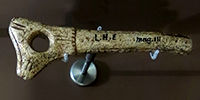 Bâtons Percés - Identified as early as 1866, the pierced baton has produced no less than 37 hypotheses regarding its use. Among the most often expressed uses was that of a spear head straightener, in combination with heat from a fire. On some of the artefacts traces of use, sometimes two by two, evoke the twisting of a cord through the hole. This page includes material from an important paper on the subject by Rigaud.
Bâtons Percés - Identified as early as 1866, the pierced baton has produced no less than 37 hypotheses regarding its use. Among the most often expressed uses was that of a spear head straightener, in combination with heat from a fire. On some of the artefacts traces of use, sometimes two by two, evoke the twisting of a cord through the hole. This page includes material from an important paper on the subject by Rigaud.
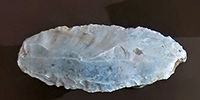 Cassegros tools - La grotte de Cassegros, has on its walls cave paintings that depict animals; paintings that reflect the prehistoric occupation of the site near the town of Trentels. It is an ideal shelter for prehistoric people because of its location. It is located on the south of a limestone hill overlooking the Lot valley, above a now dried up river. It is divided into several parts: an entrance hall, a gallery, a large room and a small chamber known as the petite salle du puits. Cave paintings have been discovered there.
Cassegros tools - La grotte de Cassegros, has on its walls cave paintings that depict animals; paintings that reflect the prehistoric occupation of the site near the town of Trentels. It is an ideal shelter for prehistoric people because of its location. It is located on the south of a limestone hill overlooking the Lot valley, above a now dried up river. It is divided into several parts: an entrance hall, a gallery, a large room and a small chamber known as the petite salle du puits. Cave paintings have been discovered there.
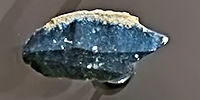 Casserole tools - l'abri Casserole is a little known Gravettian, Solutrean and early Magdalenian shelter near Les Eyzies.
Casserole tools - l'abri Casserole is a little known Gravettian, Solutrean and early Magdalenian shelter near Les Eyzies.
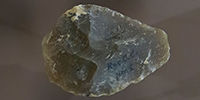 Combe-Capelle is a Mousterian / Neanderthal site situated in the Couze valley in the Périgord region of Southern France. This is a record of the tools found there by Ami and Peyrony, recorded and catalogued by Peyrony after the death of Ami, and on display at Le Musée National de Préhistoire, Les Eyzies-de-Tayac.
Combe-Capelle is a Mousterian / Neanderthal site situated in the Couze valley in the Périgord region of Southern France. This is a record of the tools found there by Ami and Peyrony, recorded and catalogued by Peyrony after the death of Ami, and on display at Le Musée National de Préhistoire, Les Eyzies-de-Tayac.
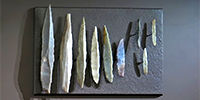
Tools from Corbiac, which is an open air Gravettian site beneath the lawns of the château de Corbiac a few kilometres NE of Bergerac, near Lembras.
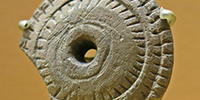 There are many examples of discs with central holes from various (mostly Magdalenian) sites in Europe. Various theories have been put forward as to their use, including clothing decoration and large buttons. As my colleague AnnDee first pointed out, their most likely use is as the weight (normally called a whorl) for a drop spindle, in the spinning of fibres into yarn. This is borne out by the fact that the overwhelming majority have a central hole, all of similar dimensions, 2 to 4 mm, and by the fact that many are not decorated in any meaningful or artistic way, and are also made of other materials (sandstone, slate) as well as bone.
There are many examples of discs with central holes from various (mostly Magdalenian) sites in Europe. Various theories have been put forward as to their use, including clothing decoration and large buttons. As my colleague AnnDee first pointed out, their most likely use is as the weight (normally called a whorl) for a drop spindle, in the spinning of fibres into yarn. This is borne out by the fact that the overwhelming majority have a central hole, all of similar dimensions, 2 to 4 mm, and by the fact that many are not decorated in any meaningful or artistic way, and are also made of other materials (sandstone, slate) as well as bone.
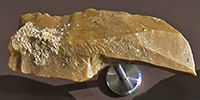 La Faurélie tools - On the left bank of the Manaurie valley, l'abri de La Faurélie II, is a few hundred metres downstream from the Aurignacian and Perigordian deposit of La Faurélie I, and ten kilometres from Les Eyzies. Discovered in 1958 by M. Lhommond, first explored by D. de Sonneville-Bordes, F. Bordes and M. Delthel, it was then meticulously excavated from 1964 to 1972 by J. Tixier.
La Faurélie tools - On the left bank of the Manaurie valley, l'abri de La Faurélie II, is a few hundred metres downstream from the Aurignacian and Perigordian deposit of La Faurélie I, and ten kilometres from Les Eyzies. Discovered in 1958 by M. Lhommond, first explored by D. de Sonneville-Bordes, F. Bordes and M. Delthel, it was then meticulously excavated from 1964 to 1972 by J. Tixier.
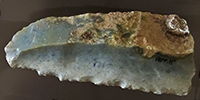 La Ferrassie rock shelter yielded skeletons from eight Neanderthal individuals, including adults, children, infants, and two fetuses. Today the skeleton of La Ferrassie 1 is considered the classic example of Neanderthal anatomy. It was discovered on 17th September 1909 by R. Capitan and D. Peyrony. This is a record of the tools found there by Peyrony, and on display at Le Musée National de Préhistoire, Les Eyzies-de-Tayac.
La Ferrassie rock shelter yielded skeletons from eight Neanderthal individuals, including adults, children, infants, and two fetuses. Today the skeleton of La Ferrassie 1 is considered the classic example of Neanderthal anatomy. It was discovered on 17th September 1909 by R. Capitan and D. Peyrony. This is a record of the tools found there by Peyrony, and on display at Le Musée National de Préhistoire, Les Eyzies-de-Tayac.
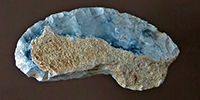 Tools from Le Flageolet I - Le Flageolet I is a small, stratified rockshelter in the Dordogne valley of southwestern France, near the town of Bezenac. The site has important Upper Palaeolithic Aurignacian and Perigordian occupations.
Tools from Le Flageolet I - Le Flageolet I is a small, stratified rockshelter in the Dordogne valley of southwestern France, near the town of Bezenac. The site has important Upper Palaeolithic Aurignacian and Perigordian occupations.
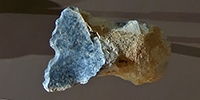 Combe Grenal is an archeological site consisting of a collapsed cave and a slope deposit near Domme, Dordogne, France. It dates from ca 175 000 to ca 50 000 BP. The cave was first thoroughly excavated by François Bordes from 1953 to 1965. The site's stratigraphic sequence is 13 metres in depth and has at least 64 layers. 55 layers are Mousterian while the 9 layers near the bottom are Acheulean. The oldest layers date back to the end of the Riss glaciation and the youngest to the Würm glaciation. This is a record of the tools found there by Bordes, and on display at Le Musée National de Préhistoire, Les Eyzies-de-Tayac.
Combe Grenal is an archeological site consisting of a collapsed cave and a slope deposit near Domme, Dordogne, France. It dates from ca 175 000 to ca 50 000 BP. The cave was first thoroughly excavated by François Bordes from 1953 to 1965. The site's stratigraphic sequence is 13 metres in depth and has at least 64 layers. 55 layers are Mousterian while the 9 layers near the bottom are Acheulean. The oldest layers date back to the end of the Riss glaciation and the youngest to the Würm glaciation. This is a record of the tools found there by Bordes, and on display at Le Musée National de Préhistoire, Les Eyzies-de-Tayac.

Decorative objects used in the Stone Age
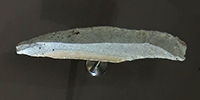
Tools from Isturitz - The deposits in the Caves of Isturitz, Oxocelhaya and Erberua date from 80 000 BP to 10 000 BP. This is a record of the tools found there by Normand, and on display at Le Musée National de Préhistoire, Les Eyzies-de-Tayac.
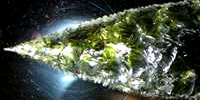
Kimberley Points - superbly made tools from the north of Australia
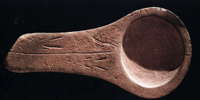 Stone Lamps of the Palaeolithic - Lamp designs fall into three main categories: open-circuit lamps consist of largely unaltered slabs of rock. When the lamp is lit, melted fat runs off through natural crevices in the rock. Closed-circuit lamps have carved depressions to contain the runoff. Carved-handle, closed-circuit lamps also have bowls shaped fuel chambers but are more finely finished and have formed extensions for easier handling. Burn marks indicate that the wick was placed away from the handle. The Lamp of Lascaux - Le Brûloir de Lascaux is a superb example of a carved handle, closed circuit lamp.
Stone Lamps of the Palaeolithic - Lamp designs fall into three main categories: open-circuit lamps consist of largely unaltered slabs of rock. When the lamp is lit, melted fat runs off through natural crevices in the rock. Closed-circuit lamps have carved depressions to contain the runoff. Carved-handle, closed-circuit lamps also have bowls shaped fuel chambers but are more finely finished and have formed extensions for easier handling. Burn marks indicate that the wick was placed away from the handle. The Lamp of Lascaux - Le Brûloir de Lascaux is a superb example of a carved handle, closed circuit lamp.
 Laugerie Haute is a treasure house of tools from the late stone age. This is the pick of the collections of Peyrony and Bordes of the sites of Laugerie Haute East and West. It is of interest primarily to those specialising in Laugerie Haute and the lithic industry of the Vézère region.
Laugerie Haute is a treasure house of tools from the late stone age. This is the pick of the collections of Peyrony and Bordes of the sites of Laugerie Haute East and West. It is of interest primarily to those specialising in Laugerie Haute and the lithic industry of the Vézère region.
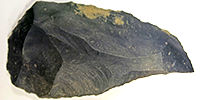 La Madeleine tools - La Madeleine is a rock shelter located in the Vézère valley, in the Dordogne, France. It is a treasure house of art and knowledge about the people of the Magdalenian. This is a record of the tools found at La Madeleine, and on display at Le Musée National de Préhistoire, Les Eyzies-de-Tayac.
La Madeleine tools - La Madeleine is a rock shelter located in the Vézère valley, in the Dordogne, France. It is a treasure house of art and knowledge about the people of the Magdalenian. This is a record of the tools found at La Madeleine, and on display at Le Musée National de Préhistoire, Les Eyzies-de-Tayac.
 Micoque tools - La Micoque is a Neanderthal site in the Dordogne dating from circa 400 000 BP to 130 000 BP. This is a record of the tools found at La Micoque, and on display at Le Musée National de Préhistoire, Les Eyzies-de-Tayac.
Micoque tools - La Micoque is a Neanderthal site in the Dordogne dating from circa 400 000 BP to 130 000 BP. This is a record of the tools found at La Micoque, and on display at Le Musée National de Préhistoire, Les Eyzies-de-Tayac.
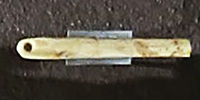 Moulin du Roc Tools - Despite the destruction of most of the filling, the Moulin du Roc site (St-Chamassy, Dordogne, France) has yielded valuable artefacts from the upper and late Magdalenian, as well as from the Sauveterrian and late Neolithic.
Moulin du Roc Tools - Despite the destruction of most of the filling, the Moulin du Roc site (St-Chamassy, Dordogne, France) has yielded valuable artefacts from the upper and late Magdalenian, as well as from the Sauveterrian and late Neolithic.
 Le Moustier is the type site for the Mousterian suite of tools and artefacts, and is a Neanderthal site. This is the pick of the collections of tools there by Peyrony. It is of interest primarily to those specialising in le Moustier and the lithic industry of the Mousterian.
Le Moustier is the type site for the Mousterian suite of tools and artefacts, and is a Neanderthal site. This is the pick of the collections of tools there by Peyrony. It is of interest primarily to those specialising in le Moustier and the lithic industry of the Mousterian.
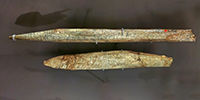 Tools from l'abri Pataud - The Abri Pataud rock shelter was occupied by the Cro Magnon man (Homo sapiens sapiens) for a period of 15 000 years, from 35 000 BP to 20 000 BP, which corresponds to the recent Wurm period, and the cultures of the Aurignacian, Gravettian and Solutrian. This is a record of the tools found at Abri Pataud by the US archaeologist Hallam L. Movius, and on display at Le Musée National de Préhistoire, Les Eyzies-de-Tayac.
Tools from l'abri Pataud - The Abri Pataud rock shelter was occupied by the Cro Magnon man (Homo sapiens sapiens) for a period of 15 000 years, from 35 000 BP to 20 000 BP, which corresponds to the recent Wurm period, and the cultures of the Aurignacian, Gravettian and Solutrian. This is a record of the tools found at Abri Pataud by the US archaeologist Hallam L. Movius, and on display at Le Musée National de Préhistoire, Les Eyzies-de-Tayac.
 Peyrugues tools - the Les Peyrugues site is a rockshelter located in the Célé valley (Lot, France), and has deposits from the last 25 millennia.
Peyrugues tools - the Les Peyrugues site is a rockshelter located in the Célé valley (Lot, France), and has deposits from the last 25 millennia.
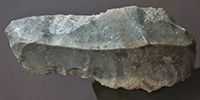 Roc de Combe was excavated by F. Bordes and J. Labrot in 1966 and 1967. Included in the stratigraphic sequence are the Mousterian , the Châtelperronian , the Aurignacian and the Gravettian. This is a record of the tools found there by Bordes, and on display at Le Musée National de Préhistoire, Les Eyzies-de-Tayac.
Roc de Combe was excavated by F. Bordes and J. Labrot in 1966 and 1967. Included in the stratigraphic sequence are the Mousterian , the Châtelperronian , the Aurignacian and the Gravettian. This is a record of the tools found there by Bordes, and on display at Le Musée National de Préhistoire, Les Eyzies-de-Tayac.



 La Madeleine tools - La Madeleine is a rock shelter located in the Vézère valley, in the Dordogne, France. It is a treasure house of art and knowledge about the people of the Magdalenian. This is a record of the tools found at La Madeleine, and on display at Le Musée National de Préhistoire, Les Eyzies-de-Tayac.
La Madeleine tools - La Madeleine is a rock shelter located in the Vézère valley, in the Dordogne, France. It is a treasure house of art and knowledge about the people of the Magdalenian. This is a record of the tools found at La Madeleine, and on display at Le Musée National de Préhistoire, Les Eyzies-de-Tayac.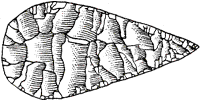

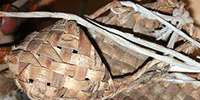
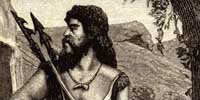
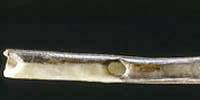




 Baguettes demi-rondes are a two-part composite projectile point technology usually manufactured from antler. This method of point construction allowed the Magdalenian toolmaker to construct a projectile point of much larger proportions, with high stiffness and strength, than the physical constraints imposed by the raw material usually allowed.
Baguettes demi-rondes are a two-part composite projectile point technology usually manufactured from antler. This method of point construction allowed the Magdalenian toolmaker to construct a projectile point of much larger proportions, with high stiffness and strength, than the physical constraints imposed by the raw material usually allowed.  Bâtons Percés - A key discovery by Conard’s team in Hohle Fels Cave in southwestern Germany is rewriting the history of rope. The find is a carefully carved and beautifully preserved piece of mammoth ivory 20.4 cm in length with four holes between 7 and 9 mm in diameter. Each of the holes is lined with deep, and precisely cut spiral incisions. The new find demonstrates that these elaborate carvings are technological features of rope-making equipment rather than just decoration.
Bâtons Percés - A key discovery by Conard’s team in Hohle Fels Cave in southwestern Germany is rewriting the history of rope. The find is a carefully carved and beautifully preserved piece of mammoth ivory 20.4 cm in length with four holes between 7 and 9 mm in diameter. Each of the holes is lined with deep, and precisely cut spiral incisions. The new find demonstrates that these elaborate carvings are technological features of rope-making equipment rather than just decoration. Bâtons Percés - Identified as early as 1866, the pierced baton has produced no less than 37 hypotheses regarding its use. Among the most often expressed uses was that of a spear head straightener, in combination with heat from a fire. On some of the artefacts traces of use, sometimes two by two, evoke the twisting of a cord through the hole. This page includes material from an important paper on the subject by Rigaud.
Bâtons Percés - Identified as early as 1866, the pierced baton has produced no less than 37 hypotheses regarding its use. Among the most often expressed uses was that of a spear head straightener, in combination with heat from a fire. On some of the artefacts traces of use, sometimes two by two, evoke the twisting of a cord through the hole. This page includes material from an important paper on the subject by Rigaud. Cassegros tools - La grotte de Cassegros, has on its walls cave paintings that depict animals; paintings that reflect the prehistoric occupation of the site near the town of Trentels. It is an ideal shelter for prehistoric people because of its location. It is located on the south of a limestone hill overlooking the Lot valley, above a now dried up river. It is divided into several parts: an entrance hall, a gallery, a large room and a small chamber known as the petite salle du puits. Cave paintings have been discovered there.
Cassegros tools - La grotte de Cassegros, has on its walls cave paintings that depict animals; paintings that reflect the prehistoric occupation of the site near the town of Trentels. It is an ideal shelter for prehistoric people because of its location. It is located on the south of a limestone hill overlooking the Lot valley, above a now dried up river. It is divided into several parts: an entrance hall, a gallery, a large room and a small chamber known as the petite salle du puits. Cave paintings have been discovered there. Casserole tools - l'abri Casserole is a little known Gravettian, Solutrean and early Magdalenian shelter near Les Eyzies.
Casserole tools - l'abri Casserole is a little known Gravettian, Solutrean and early Magdalenian shelter near Les Eyzies.  Combe-Capelle is a Mousterian / Neanderthal site situated in the Couze valley in the Périgord region of Southern France. This is a record of the tools found there by Ami and Peyrony, recorded and catalogued by Peyrony after the death of Ami, and on display at Le Musée National de Préhistoire, Les Eyzies-de-Tayac.
Combe-Capelle is a Mousterian / Neanderthal site situated in the Couze valley in the Périgord region of Southern France. This is a record of the tools found there by Ami and Peyrony, recorded and catalogued by Peyrony after the death of Ami, and on display at Le Musée National de Préhistoire, Les Eyzies-de-Tayac. 
 There are many examples of discs with central holes from various (mostly Magdalenian) sites in Europe. Various theories have been put forward as to their use, including clothing decoration and large buttons. As my colleague AnnDee first pointed out, their most likely use is as the weight (normally called a whorl) for a drop spindle, in the spinning of fibres into yarn. This is borne out by the fact that the overwhelming majority have a central hole, all of similar dimensions, 2 to 4 mm, and by the fact that many are not decorated in any meaningful or artistic way, and are also made of other materials (sandstone, slate) as well as bone.
There are many examples of discs with central holes from various (mostly Magdalenian) sites in Europe. Various theories have been put forward as to their use, including clothing decoration and large buttons. As my colleague AnnDee first pointed out, their most likely use is as the weight (normally called a whorl) for a drop spindle, in the spinning of fibres into yarn. This is borne out by the fact that the overwhelming majority have a central hole, all of similar dimensions, 2 to 4 mm, and by the fact that many are not decorated in any meaningful or artistic way, and are also made of other materials (sandstone, slate) as well as bone.  La Faurélie tools - On the left bank of the Manaurie valley, l'abri de La Faurélie II, is a few hundred metres downstream from the Aurignacian and Perigordian deposit of La Faurélie I, and ten kilometres from Les Eyzies. Discovered in 1958 by M. Lhommond, first explored by D. de Sonneville-Bordes, F. Bordes and M. Delthel, it was then meticulously excavated from 1964 to 1972 by J. Tixier.
La Faurélie tools - On the left bank of the Manaurie valley, l'abri de La Faurélie II, is a few hundred metres downstream from the Aurignacian and Perigordian deposit of La Faurélie I, and ten kilometres from Les Eyzies. Discovered in 1958 by M. Lhommond, first explored by D. de Sonneville-Bordes, F. Bordes and M. Delthel, it was then meticulously excavated from 1964 to 1972 by J. Tixier.
 La Ferrassie rock shelter yielded skeletons from eight Neanderthal individuals, including adults, children, infants, and two fetuses. Today the skeleton of La Ferrassie 1 is considered the classic example of Neanderthal anatomy. It was discovered on 17th September 1909 by R. Capitan and D. Peyrony. This is a record of the tools found there by Peyrony, and on display at Le Musée National de Préhistoire, Les Eyzies-de-Tayac.
La Ferrassie rock shelter yielded skeletons from eight Neanderthal individuals, including adults, children, infants, and two fetuses. Today the skeleton of La Ferrassie 1 is considered the classic example of Neanderthal anatomy. It was discovered on 17th September 1909 by R. Capitan and D. Peyrony. This is a record of the tools found there by Peyrony, and on display at Le Musée National de Préhistoire, Les Eyzies-de-Tayac.
 Tools from Le Flageolet I - Le Flageolet I is a small, stratified rockshelter in the Dordogne valley of southwestern France, near the town of Bezenac. The site has important Upper Palaeolithic Aurignacian and Perigordian occupations.
Tools from Le Flageolet I - Le Flageolet I is a small, stratified rockshelter in the Dordogne valley of southwestern France, near the town of Bezenac. The site has important Upper Palaeolithic Aurignacian and Perigordian occupations. Combe Grenal is an archeological site consisting of a collapsed cave and a slope deposit near Domme, Dordogne, France. It dates from ca 175 000 to ca 50 000 BP. The cave was first thoroughly excavated by François Bordes from 1953 to 1965. The site's stratigraphic sequence is 13 metres in depth and has at least 64 layers. 55 layers are Mousterian while the 9 layers near the bottom are Acheulean. The oldest layers date back to the end of the Riss glaciation and the youngest to the Würm glaciation. This is a record of the tools found there by Bordes, and on display at Le Musée National de Préhistoire, Les Eyzies-de-Tayac.
Combe Grenal is an archeological site consisting of a collapsed cave and a slope deposit near Domme, Dordogne, France. It dates from ca 175 000 to ca 50 000 BP. The cave was first thoroughly excavated by François Bordes from 1953 to 1965. The site's stratigraphic sequence is 13 metres in depth and has at least 64 layers. 55 layers are Mousterian while the 9 layers near the bottom are Acheulean. The oldest layers date back to the end of the Riss glaciation and the youngest to the Würm glaciation. This is a record of the tools found there by Bordes, and on display at Le Musée National de Préhistoire, Les Eyzies-de-Tayac.
 Stone Lamps of the Palaeolithic - Lamp designs fall into three main categories: open-circuit lamps consist of largely unaltered slabs of rock. When the lamp is lit, melted fat runs off through natural crevices in the rock. Closed-circuit lamps have carved depressions to contain the runoff. Carved-handle, closed-circuit lamps also have bowls shaped fuel chambers but are more finely finished and have formed extensions for easier handling. Burn marks indicate that the wick was placed away from the handle. The Lamp of Lascaux - Le Brûloir de Lascaux is a superb example of a carved handle, closed circuit lamp.
Stone Lamps of the Palaeolithic - Lamp designs fall into three main categories: open-circuit lamps consist of largely unaltered slabs of rock. When the lamp is lit, melted fat runs off through natural crevices in the rock. Closed-circuit lamps have carved depressions to contain the runoff. Carved-handle, closed-circuit lamps also have bowls shaped fuel chambers but are more finely finished and have formed extensions for easier handling. Burn marks indicate that the wick was placed away from the handle. The Lamp of Lascaux - Le Brûloir de Lascaux is a superb example of a carved handle, closed circuit lamp.  Laugerie Haute is a treasure house of tools from the late stone age. This is the pick of the collections of Peyrony and Bordes of the sites of Laugerie Haute East and West. It is of interest primarily to those specialising in Laugerie Haute and the lithic industry of the Vézère region.
Laugerie Haute is a treasure house of tools from the late stone age. This is the pick of the collections of Peyrony and Bordes of the sites of Laugerie Haute East and West. It is of interest primarily to those specialising in Laugerie Haute and the lithic industry of the Vézère region.  Micoque tools - La Micoque is a Neanderthal site in the Dordogne dating from circa 400 000 BP to 130 000 BP. This is a record of the tools found at La Micoque, and on display at Le Musée National de Préhistoire, Les Eyzies-de-Tayac.
Micoque tools - La Micoque is a Neanderthal site in the Dordogne dating from circa 400 000 BP to 130 000 BP. This is a record of the tools found at La Micoque, and on display at Le Musée National de Préhistoire, Les Eyzies-de-Tayac. Moulin du Roc Tools - Despite the destruction of most of the filling, the Moulin du Roc site (St-Chamassy, Dordogne, France) has yielded valuable artefacts from the upper and late Magdalenian, as well as from the Sauveterrian and late Neolithic.
Moulin du Roc Tools - Despite the destruction of most of the filling, the Moulin du Roc site (St-Chamassy, Dordogne, France) has yielded valuable artefacts from the upper and late Magdalenian, as well as from the Sauveterrian and late Neolithic. Le Moustier is the type site for the Mousterian suite of tools and artefacts, and is a Neanderthal site. This is the pick of the collections of tools there by Peyrony. It is of interest primarily to those specialising in le Moustier and the lithic industry of the Mousterian.
Le Moustier is the type site for the Mousterian suite of tools and artefacts, and is a Neanderthal site. This is the pick of the collections of tools there by Peyrony. It is of interest primarily to those specialising in le Moustier and the lithic industry of the Mousterian. Tools from l'abri Pataud - The Abri Pataud rock shelter was occupied by the Cro Magnon man (Homo sapiens sapiens) for a period of 15 000 years, from 35 000 BP to 20 000 BP, which corresponds to the recent Wurm period, and the cultures of the Aurignacian, Gravettian and Solutrian. This is a record of the tools found at Abri Pataud by the US archaeologist Hallam L. Movius, and on display at Le Musée National de Préhistoire, Les Eyzies-de-Tayac.
Tools from l'abri Pataud - The Abri Pataud rock shelter was occupied by the Cro Magnon man (Homo sapiens sapiens) for a period of 15 000 years, from 35 000 BP to 20 000 BP, which corresponds to the recent Wurm period, and the cultures of the Aurignacian, Gravettian and Solutrian. This is a record of the tools found at Abri Pataud by the US archaeologist Hallam L. Movius, and on display at Le Musée National de Préhistoire, Les Eyzies-de-Tayac.  Peyrugues tools - the Les Peyrugues site is a rockshelter located in the Célé valley (Lot, France), and has deposits from the last 25 millennia.
Peyrugues tools - the Les Peyrugues site is a rockshelter located in the Célé valley (Lot, France), and has deposits from the last 25 millennia.
 Roc de Combe was excavated by F. Bordes and J. Labrot in 1966 and 1967. Included in the stratigraphic sequence are the Mousterian , the Châtelperronian , the Aurignacian and the Gravettian. This is a record of the tools found there by Bordes, and on display at Le Musée National de Préhistoire, Les Eyzies-de-Tayac.
Roc de Combe was excavated by F. Bordes and J. Labrot in 1966 and 1967. Included in the stratigraphic sequence are the Mousterian , the Châtelperronian , the Aurignacian and the Gravettian. This is a record of the tools found there by Bordes, and on display at Le Musée National de Préhistoire, Les Eyzies-de-Tayac.